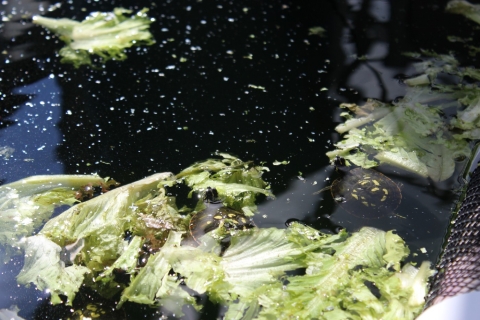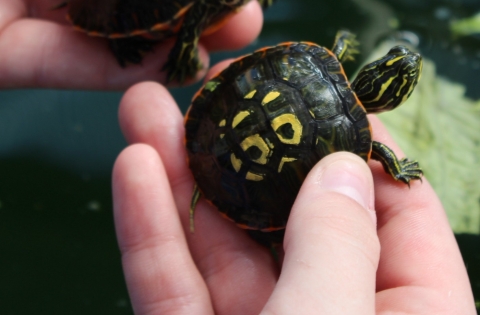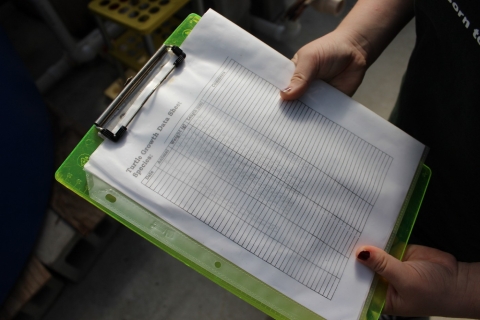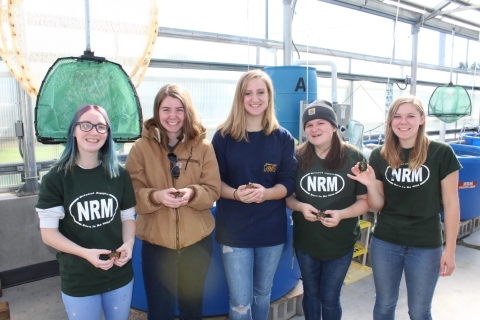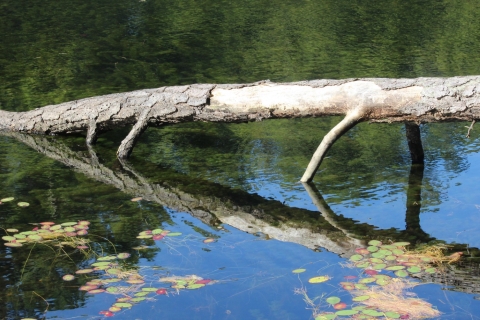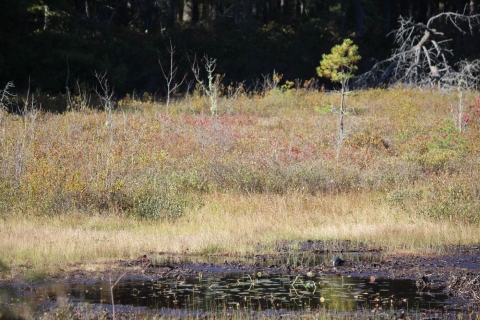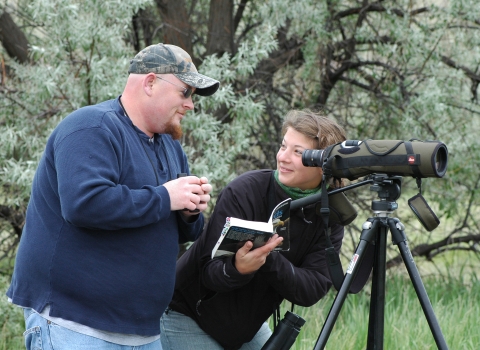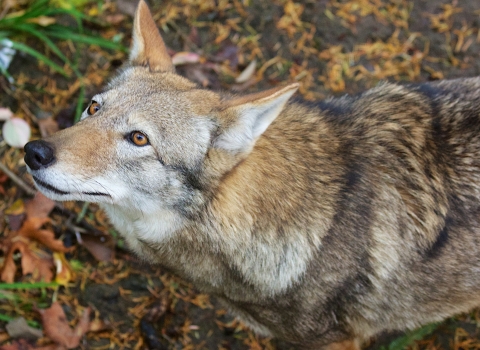After stepping through a disinfecting foot bath, and passing around a bottle of Purell, five seniors at Bristol County Agricultural High School led me over to an aquaculture tank the size of a hot tub. It contained 35 turtles, each smaller than the palm of my hand, and countless pieces of red-leaf lettuce floating on the surface to help them get bigger.
“Sorry, should I have used the sanitizer?” I asked, juggling an audio recorder and a camera.
“That’s okay!” Cheylene Ferreira reassured me. “As long as you don’t touch them.”
Covered with intricate swirling patterns of olive green and pale yellow, their heads, arms, and legs looked as if they were made of polymer clay. Their undersides, or plastrons, were like inkblot tests in black and traffic-cone orange, not yet their namesake red.
They are young northern red-bellied cooters, and the students at the high school in Bristol County have cared for them since they were the size of a quarter. They will continue to do so until they are big enough to survive in the wild. That is, bigger than the palm of my hand.
Not too long ago, this turtle was associated exclusively with another county in southeastern Massachusetts. In the late 1970s, biologists estimated that there were only 200 northern red-bellied cooters left in the state — and they could all be found in just 12 ponds in Plymouth County. Thought to be a subspecies of the more broadly distributed northern red-bellied cooter, this isolated population was deemed the Plymouth red-bellied cooter, and has been protected under the federal Endangered Species Act since 1980.
Over the past four decades, taxonomists have revisited the classification issue — the Plymouth-county cooters are now understood to be a disjunct population of the northern red-bellied cooter, rather than a subspecies — and partners have helped restore their numbers in Massachusetts, thanks in large part to MassWildlife’s Headstart Program.
The state coordinates with museums, nonprofit organizations, and schools like Bristol Aggie to provide temporary foster homes to hatchling cooters, taken from their nests when they are particularly vulnerable to predation, by the likes of largemouth bass and great blue heron, simply because they are so small. In the wild, few hatchling turtles live to see their first birthday. More than 80 percent of released head-started turtles do; when they return to their natal ponds, they grow faster and are significantly bigger than their wild counterparts. Too big for a heron to swallow.
“We are in the 34th year of the head-starting program, and we’ve now released 4,334 head-started cooters into 33 sites, including many of the 12 ponds where they were originally found,” said state herpetologist Mike Jones. All of the cooters are marked with distinct notches in their shells — and since 2013, with Passive Integrated Transponder (PIT) tags — so scientists can keep track of how cooters are doing now, and in the future.
So far, so good, would be an understatement. Massachusetts just completed a four-year study in partnership with the U.S. Fish and Wildlife Service that suggests the cooter population is ten times what it was in 1980, and that’s a conservative estimate.
“We have gone into some of the populations that were entirely new — where we had reason to believe there were no cooters in the 1980s — and found cooters that survived at very high rates, above 94 percent annually,” Jones said. “The first-generation head-starts have been reproducing at those ponds, and now their offspring are nearing reproductive age.” That’s an important milestone, given the life history of turtles; few survive to adulthood, but once they make it, they can reproduce every year for the rest of their naturally long lives: upwards of 80 years.
In addition to affirming the success of the program, this research will help them refine the recovery effort moving forward. “Although the total population far exceeds what it used to be, certain ponds seem to have low recruitment,” Jones said. Sort of like a small town where the population is declining, maybe because there are no young couples starting new families, or because everyone moves to the big city after finishing high school.
“So until we figure out what’s happening in those ponds, we will continue to keep populations stable using this tried and true method,” Jones said.
There is another reason to keep the head-start program going. Something else has grown in step with the cooter population in Massachusetts: awareness about their plight.
Always ready to disappear
Cooters appeared on the radar of the scientific community in 1916, and Jones says they were probably already rare.
But for nearly 70 years, they kept a low profile. Partly because that’s their nature. As naturalist Harold L. Babcock observed in his 1919 monograph, The Turtles of New England, northern red-bellied cooters are “alert, active, and very shy…always ready to disappear quickly at the slightest sign of danger.”
Even the hatchlings that spend up to ten months in captivity don’t warm up to humans, which will benefit them in the wild. “They never really get un-skittish, like the others,” said Serina Corenell, one of the seniors at Bristol Aggie, comparing the cooters to other species her school fosters. “The Blanding’s turtles will swim right up to you.”
Although the feeling may not be mutual, the students have clearly grown fond of the shy turtles in their care, and that relationship underscores the value of the head-start program. In the beginning, MassWildlife worked with a few key partners — like the New England Aquarium and the Roger Williams Park Zoo — to pilot the program. Because juvenile turtles are so vulnerable, it was critical to ensure they were handled by professionals.
Now with support from State Wildlife and Endangered Species Grant funding from the Service, MassWildlife partners with two dozen institutions, including several schools, where staff have the expertise to care for wild turtles, and the proper equipment to house them. Think hot-tub sized aquaculture tank. The hundreds of students who have given thousands of turtles a head start since the 1980s would probably never have heard of, or cared about, this species otherwise. They have played an important role at a formative time in the lives of these turtles, and the turtles have played an important role at a formative time in the lives of the students too.
I asked the students at Bristol Aggie how they would feel if their work made it possible to remove this species from the endangered species list; the turtle’s status is up for review in 2019. There were a few “Awesome!”s in unison, but Ferreira articulated what it would really mean to them: “I wouldn’t want any recognition or anything, but I would know, and that makes me feel good.”
Light at the end of the tunnel
After leaving the high school, I headed to Plymouth County in search of cooters. It was a sunny afternoon in mid-October, perhaps one of the last opportunities of the season to see turtles before they burrow into the mud for the winter to enter a state called brumation.
Bristol Aggie’s Natural Resource Department Chair Brian Bastarache, who oversees the school’s turtle operation, had shown me exactly where to look, drawing a map to a large coastal pond in a state park where there were a few trees down in the water right near the parking area. If the cooters were out today, they would be sunbathing on those logs.
Despite my determined staring, they weren’t. But I decided to make the most of the afternoon, and followed a trail from the parking lot into the pine forest. After a few minutes, the trail reached a marshy inlet from the pond, and began to trace the shoreline. Now walking beside the water, I allowed my eyes to occasionally wander into the marsh, in search of something turtle shaped.
And then to my surprise, they found it: a full-sized northern red-bellied cooter, sitting in the muck about 50 yards away, holding its head up into the light.
I later learned that this pond was not one of the original 12 in which cooters were thought to be isolated the 1980s. The cooter I saw had been given a head start, and it never looked back.
Thanks to coordination and collaboration with public and private partners, more than 185 species in the eastern United States have recovered, been downlisted, or did not need listing under the Endangered Species Act. The effort to conserve at-risk wildlife and recover listed species is led by the Service and state wildlife agencies in partnership with other organizations. Our use of conservation incentives and flexibilities to protect wildlife, reduce regulations and keep working lands working has drawn bipartisan support from Congress.


